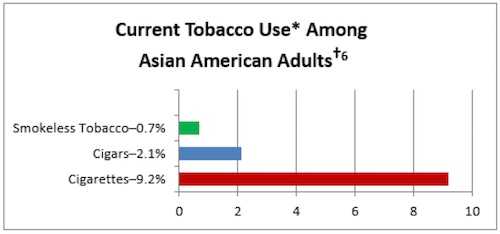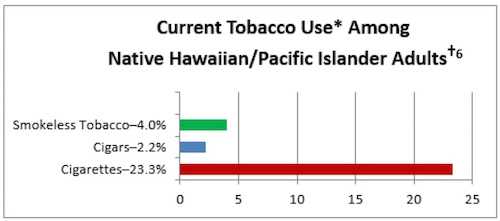Asian Americans, Pacific Islanders, Native Hawaiians and Tobacco Use
Asian American is defined by the Office of Management and Budget as “a person having origins in any of the original peoples of the Far East, Southeast Asia, or the Indian subcontinent.”1 The six largest subgroups of Asian Americans are from China, the Philippines, India, Korea, Vietnam, and Japan.2
Native Hawaiian or Other Pacific Islander is defined as “a person having origins in any of the original peoples of Hawaii, Guam, Samoa, or other Pacific Islands.”1
There were over 17 million Asian Americans in the United States in 2014—approximately 5.4% of the total U.S. population. Native Hawaiians or Other Pacific Islanders made up 0.2% of the population in 2014.3
Cigarette smoking among Asian American/Pacific Islander adults is lower than other racial ethnic groups.4 However, prevalence varies among sub-groups within the Asian American/Pacific Islander/Native Hawaiian population.5

Tobacco Use Prevalence
10.9% of Asian Americans reported current use* of tobacco in 2013.6

28.1% of Native Hawaiians/Pacific Islanders reported current use* of tobacco in 2013.6

By sub-groups, prevalence of cigarette smoking among Asian Americans varies considerably:7
| Asian Sub-Group | Cigarette Smoking Prevalence§7 |
|---|---|
| Chinese | 7.6% |
| Asian Indian | 7.6% |
| Japanese | 10.2% |
| Filipino | 12.6% |
| Vietnamese | 16.3% |
| Korean | 20.0% |
* “Use” is defined as self-reported consumption of cigarettes, cigars, or smokeless tobacco in the past month.
† Data taken from the National Survey on Drug Use and Health (NSDUH), 2013, and refer to Asian American adults aged 18 years and older.
§ Data taken from NSDUH, 2010–2013, and include persons aged 18 years and older who reported smoking cigarettes during the past month.
Health Effects
The three leading causes of death among Asian Americans and Pacific Islanders are cancer, heart disease, and stroke,8 all of which can be caused by cigarette smoking.
- Lung cancer is the leading cause of cancer death among Asian Americans/Pacific Islanders.9 Within this population—
- Hawaiian men and women have the highest rates of lung cancer deaths.9
- Filipino men and women have the lowest rates of lung cancer deaths.9
Patterns of Tobacco Use
Cigarette smoking varies by Asian American subgroups as a result of a number of cultural, social, environmental, and individual factors.9
- In general, Asian Americans and Pacific Islanders tend to be light, non-daily smokers.10
- One study among Asian American and Pacific Islander college students in California showed that:
- 48% of current smokers smoke cigarettes on fewer than 2 days per month.10
- 46% of current smokers smoke less than 2 cigarettes per day.10
- Cigarette smoking during pregnancy is less common among Asian American/Pacific Islander women compared to other racial/ethnic groups.11
Quitting Behavior
- Among Asian American current daily cigarette smokers aged 18 years and older:
- 63.3% report that they want to quit compared to 74.1% of African Americans, 69.4% of whites, 58.4% of Hispanics, and 52.1% of American Indians/Alaska Natives.12
- 39.4% report attempting to quit during the past year compared to 51.8% of Hispanics, 49.3% of African Americans, and 40.9% of whites.12

Tobacco Industry Marketing and Influence
Tobacco companies have been creative in their efforts to reach different racial/ethnic groups. Asian smokers are a key market for tobacco companies since cigarette smoking prevalence in most Asian countries is considerably higher than in the U.S.9,13
- The tobacco industry has sponsored Chinese New Year and Vietnamese New Year festivals and other activities related to Asian/Pacific American Heritage Month.13
- Tobacco advertisements on billboards and in stores are more plentiful in predominantly urban Asian American communities than in other urban neighborhoods.13
- Tobacco companies promote themselves among Asian American business owners by supporting their business associations and offering special retail sales materials.13

Culturally appropriate anti-smoking health marketing strategies and mass media campaigns like CDC’s Tips From Former Smokers national tobacco education campaign, as well as CDC-recommended tobacco prevention and control programs and policies, can help reduce the burden of disease among the Asian American/Pacific Islander/Native Hawaiian population.
Resources
Fact Sheets and Guides
- Tobacco Use in Asian American Communities Fact Sheet [PDF–1 MB]
- Tobacco and Health in Asian American, Native Hawaiian, and Pacific Islander Communities in California Fact Sheet [PDF–677 KB]
- American Cancer Society Guide to Quitting Smoking [PDF–223 KB]
Websites
- American Cancer Society
- Asian Pacific Partners for Empowerment, Advocacy & Leadership (Appeal)
- Americans For Nonsmokers’ Rights
Special Publication
Disparities in Adult Cigarette Smoking—United States, 2002–2005 and 2010–2013
Although cigarette smoking has declined significantly since the release of the 1964 Surgeon General’s Report on Smoking and Health, disparities in tobacco use varies among racial/ethnic populations. Moreover, estimates of U.S. adult cigarette smoking and tobacco use are usually limited to aggregate racial or ethnic population categories (non-Hispanic whites (whites), non-Hispanic blacks or African Americans (blacks), American Indians and Alaska Natives (AI/ANs), Asians, Native Hawaiians or Pacific Islanders (NHPI), and Hispanics/Latinos; these estimates can mask differences in cigarette smoking prevalence among subgroups of these populations.
References
- Government Printing Office. Revisions to the Standards for the Classification of Federal Data on Race and Ethnicity, 1997 [PDF–156 KB]. [accessed 2017 Mar 1].
- Reeves TJ, Bennett CE. We The People: Asians in the United States [PDF–479 KB]. Washington, D.C.: U.S. Department of Commerce, Economics and Statistics Administration, U.S. Census Bureau, 2004 [accessed 2016 Aug 10].
- U.S. Census Bureau. Population Estimates, 2015 [accessed 2016 Aug 10].
- Centers for Disease Control and Prevention. Current Cigarette Smoking Among Adults—United States, 2005-2013. Morbidity and Mortality Weekly Report 2014:63(47);1108–12 [accessed 2016 Aug 10].
- Caraballo RS, Yee SL, Gfroerer J, Mirza S. Adult Tobacco Use Among Racial and Ethnic Groups Living in the United States 2002–2005 [PDF–447 KB]. Preventing Chronic Disease: Public Health Research, Practice, and Policy 2008;5(3):1–6 [accessed 2016 Aug 10].
- Substance Abuse and Mental Health Services Administration. Results from the 2013 National Survey on Drug Use and Health: Detailed Tables, Table 2.21B. Rockville, MD: Substance Abuse and Mental Health Services Administration, Center for Behavioral Health Statistics and Quality, 2014 [accessed 2016 Aug 10].
- Centers for Disease Control and Prevention. Disparities in Adult Cigarette Smoking—United States, 2002-2005 and 2010-2013. Morbidity and Mortality Weekly Report, 2016;65(30) [accessed 2016 Aug 10].
- Heron, M. Deaths: Leading Causes for 2010 [PDF–5.08 MB]. National Vital Statistics Reports, 2013;62(6) [accessed 2016 Aug 10].
- U.S. Department of Health and Human Services. Tobacco Use Among U.S. Racial/Ethnic Minority Groups—African Americans, American Indians and Alaska Natives, Asian Americans and Pacific Islanders, Hispanics: A Report of the Surgeon General. Atlanta: U.S. Department of Health and Human Services, Centers for Disease Control and Prevention, National Center for Chronic Disease Prevention and Health Promotion, Office on Smoking and Health, 1998 [accessed 2016 Aug 10].
- Romero DR, Pulvers K. Cigarette Smoking Among Asian American and Pacific Islander College Students: Implications for College Health Promotion. Health Promotion Practice 2013;14(Suppl 1):61S–9S [cited 2016 Aug 10].
- Centers for Disease Control and Prevention. Trends in Smoking Before, During, and After Pregnancy—Pregnancy Risk Assessment Monitoring System, United States, 40 Sites, 2000–2010. Morbidity and Mortality Weekly Report, 2013:62(SS06):1–19 [accessed 2016 Aug 10].
- U.S. Department of Health and Human Services. The Health Consequences of Smoking: 50 Years of Progress. A Report of the Surgeon General. Atlanta: U.S. Department of Health and Human Services, Centers for Disease Control and Prevention, National Center for Chronic Disease Prevention and Health Promotion, Office on Smoking and Health, 2014 [accessed 2016 Aug 10].
- National Cancer Institute. The Role of the Media in Promoting and Reducing Tobacco Use [PDF–6.50 MB]. Smoking and Tobacco Control Monograph No. 19, NIH Pub. No. 07-6242, June 2008 [accessed 2016 Aug 10].
For Further Information
Centers for Disease Control and Prevention
National Center for Chronic Disease Prevention and Health Promotion
Office on Smoking and Health
E-mail: tobaccoinfo@cdc.gov
Phone: 1-800-CDC-INFO
Media Inquiries: Contact CDC’s Office on Smoking and Health press line at 770-488-5493.
- Page last reviewed: March 1, 2017
- Page last updated: March 1, 2017
- Content source:


 ShareCompartir
ShareCompartir